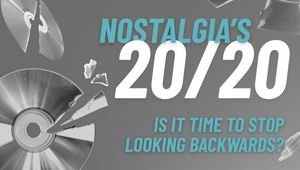
What Matters Most to Today’s Advertising Professionals of Colour

Myron King is the chief integration officer at VMLY&R and leads its Inclusion Experience consulting practice in designing successful and sustainable cultural transformation programmes for enterprise brands. VMLY&R is committed to continuously making positive changes that will impact equity and inclusion in our industry and society at large.
Welcome to 2023, the fourth year of a decade that history will look back on and likely call the “Tumultuous Twenties.”
When you consider the range of events - the ongoing COVID-19 pandemic, the social justice upheaval of 2020, the January 6th insurrection, increasing climate instability, unprecedented inflation and an unprovoked war in Ukraine - “tumultuous” may very well be an understatement.
The point is, the past few years have been a uniquely complex and trying time for most of us.
Whether by force or by choice, many of us and our colleagues, teammates, and friends have reassessed what’s most important in our lives and made a variety of adjustments to accommodate shifts in the hierarchy of our personal and professional needs.
Back in 2021, we started an advertising industry wide research initiative to identify and surface the underlying reasons why advertising professionals of colour were switching jobs at a rate much higher than their nonminority counterparts. That research, titled “Blueprint for Belonging,” suggested that compensation was necessary, but insufficient, to maintain and foster a diverse and inclusive workplace.
“While higher titles and compensation are easy ways of explaining BIPOC job movement, we’d be naive to overlook the qualitative aspects of workday life that make departing easier — or in some cases, inevitable. It’s about the employee experience. Agencies need to earn the confidence of their people, to make infrastructure changes that make people feel safe. They need both inclusive recruitment and inclusive retention.” (Myron, Nelson and O’Shea, 2021).
In the time since we published the initial report, the Great Resignation gave way to a different phenomenon that pundits labelled “quiet quitting”: “opting out of tasks beyond one’s assigned duties and/or becoming less psychologically invested in work” (Klotz and Bolino, 2022).
Our examination of this phenomenon continues, and we’ve released the second round of our Blueprint for Belonging research. The study surveys 1,200 professionals in advertising and other adjacent industries regarding their needs and motivations for staying with their current company or seeking alternative companies and/or careers.
The findings show that the job market is still an inferno of disarray and that professionals of colour are considering leaving their jobs (and even the advertising industry at large) at a greater rate than their white counterparts when the foundational needs of compensation equity and promotion are not met.
Tenured advertising professionals are at the highest risk of searching for a new role, placing ad agencies at risk of losing the very talent and wisdom that built the business. Additionally, talented young professionals are increasingly motivated to find a company that meets their foundational needs.
Industry leaders can do much to improve the work experience for professionals of colour in advertising, and doing so drives retention and higher performance. A recent Gartner study concluded that “sustainable DEI initiatives demonstrate a 20% increase in inclusion, which corresponds to greater on-the-job effort and intent to stay, as well as high employee performance” (Wiles and Turner, 2022).
Further, data analysed by SHRM shows that nine out of 10 workers (90%) who rate their company’s culture as poor have thought about quitting, compared with 72% of workers who rate their organisational culture as average and 32% who rate their culture as good” (SHRM, 2022).
When you assemble these points together, a pyramid not unlike that used to teach Abraham Maslow’s hierarchy of needs emerges.

(Figure 1 - Maslow’s Hierarchy of Needs).
In Maslow’s hierarchy, the bottom two tiers, consisting of physical needs and safety needs, respectively, make up the foundation.

(Figure 2: Ad pros of colour hierarchy of value)
For advertising professionals of colour, the bottom two tiers are compensation and promotion, respectively. As these foundational needs are met or secured, parts of our behaviour will be motivated by the next tier: belonging. The other two tiers (esteem and self-actualisation) are certainly important, but our latest research suggests that prioritisation of these needs shifts dramatically for advertising pros of colour.
For instance, Black and Hispanic advertising professionals prioritise tangible needs like a competitive salary above intangible needs by 50% and 48%, respectively; 46% of Asian advertising professionals in our survey cited an emotionally supportive environment as a top priority; and 51% of white advertising professionals cited a flexible schedule as a top priority for staying in their current roles (Figure 3).

(Figure 3: Top reasons for staying by identity)
The importance of belonging cannot be understated. It is the glue that bonds people together - from families and friends to communities, cultures, and companies. But, the ties will only be as strong as our connection to what needs matter most and our collective actions to fulfil them. The following three takeaways are important ones to note and act upon:
- Belonging is a balancing act that requires thoughtfulness at every moment: For advertising professionals of colour, belonging is not a singular noun. It is a multifaceted equation with variables that change in weight from one moment to the next; one meeting, one email, one IM, one passing glance can change DEI outcomes at the individual level, which is the most critical level for cultural change to be successful.
- Spending on programs to change individual mindset and behaviour change must continue, especially at the manager level: Setting the stage for individual mindset shifts and rewarding behaviour changes that model best practices are priority investments for companies that are serious about success now and over the next 50 years. While executive leadership and participation is necessary for successful cultural transformation to take shape, it is not sustainable without training on matters of multiculturalism, unintentional bias, behaviour modelling, and specific feedback loops to measure adaptation over time and impact on belonging.
- Failure to address pay and promotion equity for professionals of colour jeopardises DEIB and ESG success: Equity in pay and promotion opportunities are the most crucial factors in the DEIB equation. While investments in employee engagement are essential to successful cultural transformation, failure to understand, address, and measure change across these two foundational elements undermines the ROI of DEIB efforts and threatens broader ESG credibility for shareholders.
Companies must continue their recent success in recruitment but adjust their retention strategies for diverse talent. It starts by understanding and addressing the importance of equitable compensation and promotion opportunities. When those aspects are credibly and transparently tackled, the delicate balance of belonging can be better achieved.















